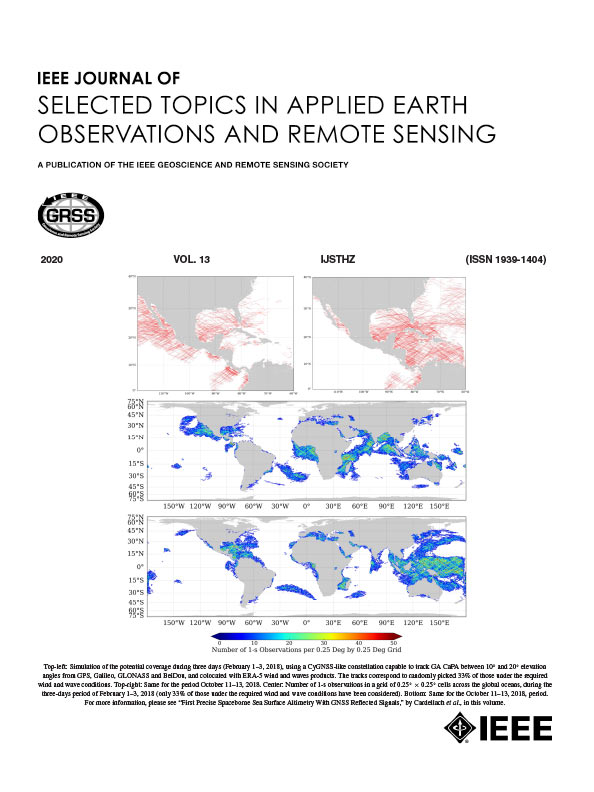DSMF-Net: A One-Stage SAR Ship Detection Network Based on Deformable Strip Convolution and Multiscale Feature Refinement and Fusion
IF 4.7
2区 地球科学
Q1 ENGINEERING, ELECTRICAL & ELECTRONIC
IEEE Journal of Selected Topics in Applied Earth Observations and Remote Sensing
Pub Date : 2025-04-09
DOI:10.1109/JSTARS.2025.3559414
引用次数: 0
Abstract
Synthetic aperture radar (SAR), an all-weather and day-and-night remote sensing imaging technology, is crucial for ship detection. However, SAR images are hampered by speckle noise and coastal clutter, and ship targets exhibit multiscale and small-scale characteristics. To tackle these challenges, we introduce the DSMF-Net, a SAR ship detection network leveraging deformable strip convolution and multiscale feature refinement and fusion. First, to counter interference from complex backgrounds, such as nearshore ports and speckle noise, the deformable strip convolution (DSConv) is introduced and incorporated into the backbone network for SAR ship feature extraction, named SSFEBackbone. DSConv adaptively adjusts convolution sampling positions based on ship target characteristics, precisely extracting features with directional and strip structures. Second, the dual-stream self-attention feature refinement module is utilized to refine high-level semantic features. Through the mixing spatial and channel attention (MSCA) mechanism, differences and correlations between complex backgrounds and ship entities are further captured, enhancing feature expression. Finally, the adaptive selective feature pyramid network is proposed. By leveraging MSCA attention, high-level semantic and low-level spatial features are flexibly matched, enabling better key information retention during fusion and background clutter suppression, thus improving detection performance for complex backgrounds and multiscale ship targets. Experimental results demonstrate that DSMF-Net performs significantly better in ship detection in SAR images. It outperforms existing state-of-the-art methods on the SAR-Ship-Dataset, high-resolution SAR images dataset, and SAR ship detection dataset, achieving an APDSMF-Net:一种基于变形条卷积和多尺度特征细化融合的单阶段SAR舰船检测网络
合成孔径雷达(SAR)是一种全天候、昼夜遥感成像技术,是舰船探测的关键技术。然而,SAR图像受到散斑噪声和海岸杂波的影响,舰船目标具有多尺度和小尺度特征。为了应对这些挑战,我们引入了DSMF-Net,这是一种利用可变形条带卷积和多尺度特征细化和融合的SAR船舶检测网络。首先,为了对抗近岸港口和散斑噪声等复杂背景的干扰,引入了可变形条带卷积(DSConv),并将其引入到SAR舰船特征提取的骨干网络中,称为SSFEBackbone;DSConv算法根据舰船目标的特征自适应调整卷积采样位置,精确提取具有方向性和条形结构的特征。其次,利用双流自关注特征细化模块对高级语义特征进行细化;通过混合空间和通道注意(MSCA)机制,进一步捕捉复杂背景和船舶实体之间的差异和相关性,增强特征表达。最后,提出了自适应选择特征金字塔网络。利用MSCA注意力,实现了高层语义特征和低层空间特征的灵活匹配,在融合过程中更好地保留关键信息,抑制背景杂波,从而提高了对复杂背景和多尺度舰船目标的检测性能。实验结果表明,DSMF-Net在SAR图像中具有较好的船舶检测效果。它在SAR-舰船数据集、高分辨率SAR图像数据集和SAR船舶检测数据集上优于现有的最先进方法,分别实现了96.8%、93.1%和97.4%的AP。
本文章由计算机程序翻译,如有差异,请以英文原文为准。
求助全文
约1分钟内获得全文
求助全文
来源期刊
CiteScore
9.30
自引率
10.90%
发文量
563
审稿时长
4.7 months
期刊介绍:
The IEEE Journal of Selected Topics in Applied Earth Observations and Remote Sensing addresses the growing field of applications in Earth observations and remote sensing, and also provides a venue for the rapidly expanding special issues that are being sponsored by the IEEE Geosciences and Remote Sensing Society. The journal draws upon the experience of the highly successful “IEEE Transactions on Geoscience and Remote Sensing” and provide a complementary medium for the wide range of topics in applied earth observations. The ‘Applications’ areas encompasses the societal benefit areas of the Global Earth Observations Systems of Systems (GEOSS) program. Through deliberations over two years, ministers from 50 countries agreed to identify nine areas where Earth observation could positively impact the quality of life and health of their respective countries. Some of these are areas not traditionally addressed in the IEEE context. These include biodiversity, health and climate. Yet it is the skill sets of IEEE members, in areas such as observations, communications, computers, signal processing, standards and ocean engineering, that form the technical underpinnings of GEOSS. Thus, the Journal attracts a broad range of interests that serves both present members in new ways and expands the IEEE visibility into new areas.

 求助内容:
求助内容: 应助结果提醒方式:
应助结果提醒方式:


